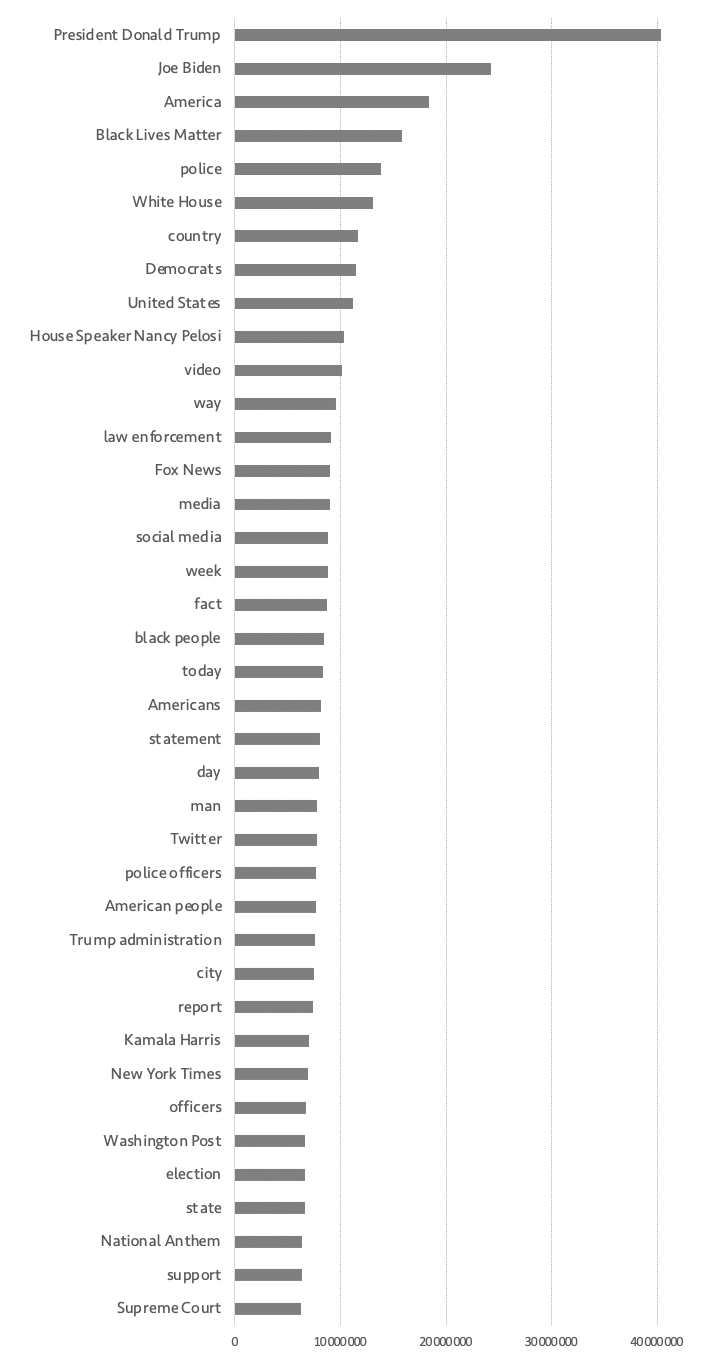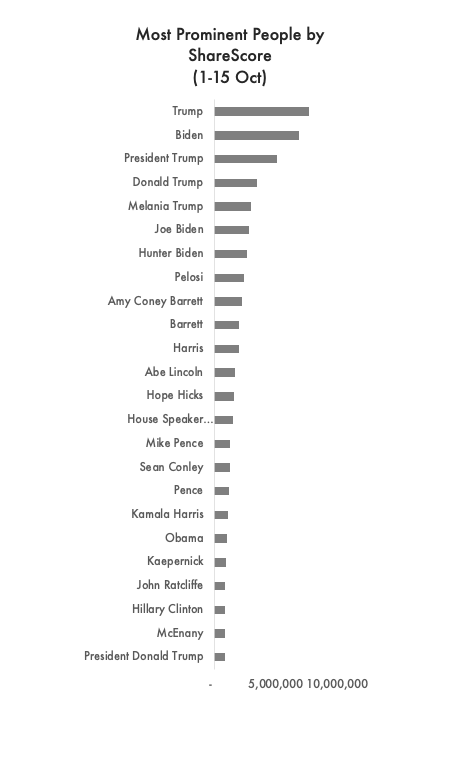Trumpland pt 1
In the past three months, a small number of right-wing news sites in the United States have seen their misleading and sensationalised content shared online more than 800 million times. Their combined engagement on social media saw them challenging the main major news networks, and in recent weeks they have pivoted from attacking civil rights protests to questioning the validity of the election.
These ‘alternative news’ sites offer a barometer of current obsessions within the Trump base. But misleading stories from these sites have also been promoted by everyone from Russian troll farms to the President’s family. Subversive narratives about race relations, political corruption and voting fraud are permeating mainstream coverage.
In this Tracking Trumpland series, we will look specifically at the biggest right-wing disinformation sites and what stories they are carrying in the run up to the US election. When we say ‘big’ we mean the largest in terms of online engagement, though you may not have heard of them. There are two objectives for this blog series:
To quantify the reach of alternative news sites
To show how topics and talking points evolve over time
See the graph below for the top topics (excluding Biden and Trump) featured on alternative right wing sites in the past three months - as measured by engagement.
“Racial and political grievances are a perennial theme, but electoral fraud is an emergent topic.”
Trumpland top topics
Based on 718 million online engagements since July 2020 (excluding candidates)
According to Pew research over a third of Americans use the web as their main news source, and 42% actively use social media as a news source (these figures increase to over 80% for local or state level news), so online disinformation matters. Commentators are generally agreed that the public is more sceptical of news read on social media than they were in 2016, but anything that dampens enthusiasm can still affect electoral outcomes.
This PJ Media story about ballot destruction was shared more than 3.2 million times, before eventually being fact checked by Reuters.
There are many efforts being made to track disinformation around the world including Media Bias/Fact Check and the Global Disinformation Index which has powered scoops by a number of outlets, including this piece in the New York Times on the replacement of real local newspapers with independent online-only mouthpieces. There have also been illuminating deep dives on particular tactics such as this piece on the leaked Hunter Biden mails by the Atlantic Council’s Digital Forensics Lab.
Our focus here is tighter – we are looking only at the tip of the iceberg, the most prominent US-based alternative news sites that have a discernible right-wing bias and a record of publishing verifiable disinformation. However, we will go a step further than human analysts could, by using machine learning to explore topics and virality within tens of thousands of different pieces of content, assessing what topics really drive interest.
Looking at the main alternative sites provides a useful indicator of what the Trump base are thinking about and reacting to in the run up to the election. We will check back in with Trumpland on the eve of the election – and look at how these platforms react to the results in the days and weeks that follow.
“We want to know how Trump supporters react in the days and weeks after they secure victory or suffer defeat. ”
Context
The upcoming US Presidential election promises to be a fraught affair, with an already polarised electorate torn further apart in the midst of the Coronavirus pandemic and growing economic uncertainty.
Trump and figures close to him have appeared to suggest at times that in the event of losing, a peaceful handover of power is not guaranteed, primarily due to speculated questions over the validity of the election process, and many of these comments appear to be aimed at his hyper-loyal base.
Social networks have proved a fertile breeding ground for conspiratorial ideas, ranging from relatively banal accusations of fraud to more complex phenomena such as QAnon, which posits Trump as a lone bulwark against an all-powerful deep state run by celebrity child abusers.
Twitter and Facebook have both made desperate attempts to limit the spread of such ideas on their platform, but it still seems that they are likely to be a prime setting for dissemination of hyper-partisan media stories and organisation of grassroots resistance to any potential change of power between parties after the election.
Where we started: sites bad-mouthing Biden
To begin our analysis, we investigated the most reacted-to stories on social media about Trump’s opponent, former Vice-President Joe Biden. Looking up to the end of September, we identified 15 less-established (or ‘alternative’) conservative news sites which collectively accounted for more than a quarter (27%) of social media engagements concerning Joe Biden in 2020 – totalling 156,737,309 reactions between them. This list excludes mainstream right-wing sites like Fox News and the New York Post, and sites that have struggled with disinformation but have no inherent political bias, like YouTube.
15 Biggest Trumpland News Sites
Based on over 30 million shares of coverage around Joe Biden
According to Media Bias Fact Check, all of these sites are known to produce and promote actual disinformation, though it is worth noting that Babylon Bee is a conservative-leaning satire website so it is to be expected that articles will not be strictly factual. (We kept Babylon Bee in because the spoof articles are all topical and reflect the changing interests of readers. Only a vanishingly small proportion of readers would not recognise the site as satirical - although this is apparently the case for Donald Trump.) These 15 sites are only a small sample of partisan sources in the US. However, they encapsulate a different perspective, less well understood than mainstream media but equally pervasive.
Far From Fringe
For this analysis we included in our sample all articles published on these 15 websites with 50,000+ reactions over the course of 3.5 months (July 1 – October 15th 2020). That is a massive threshold for engagement, with many viral news sites happy to drive 1/10 of that engagement for political news. During the months since July these sites published over 5,000 qualifying articles attracting a total of more than 800 million social media reactions. For context, that level of engagement goes far beyond the dreams of most political campaigns, and easily eclipses the rate of online engagement reported around the 2016 Trump vs Clinton election by the National Bureau of Economic Research.
“Despite media perception that voters have ‘fake news fatigue’ and are cynical about what they read online - US voters are reading, and sharing misleading content more than ever in the run up to this election.”
The 15 sites we studied published a number of very popular and highly incendiary pieces, including on election rigging, climate change and civil unrest. See below for the biggest stories of the last three months. (highlighted articles are from satire website Babylon Bee).
Most viral stories in Trumpland media (past 3 months)
Many of the key narratives underpinning alt-right sentiment are evident; paranoia about the deep state, terror of a racialised Other and, in the Darryl Daniels article about the shooting of a young child, lionising vigilante violence.
It seems probable that, should any major right-wing unrest spill out of the events of the next few months, these sources will prove pivotal in shaping and reflecting radical right-wing narratives.
ShareScore: diving deeper with machine learning
We’re using our proprietary ShareScore technology to track these sources in the build-up to and aftermath of the election, in the belief that this is where mass right-wing disinformation and resentment may unfold.
ShareScore is a technology used to track the interplay of themes, entities and keywords in shaping how news is reacted to online. The technology uses Natural Language Classifiers to scan through web content in order to find the most relevant items in the text, and a score is calculated based on the relevance of items in the text and the amount of social media reactions the content receives. ShareScore is calculated in aggregate so that we can track the emergence of different issues over time and effectively pinpoint content, topics and personalities that people really care about.
We do not hold any information about the people who are engaging, operating on totally anonymous records outlining the nature and platform of the interactions in order to get an impression of trends in society as a whole.
ShareScore: Terms of Debate
There are a number of ways to look at a piece of text, but for our purposes one of the most illuminating is the presence of keywords.
While most of the top drivers of shares are fairly obvious – pieces about Trump, Biden or America – we do not have to dig much deeper to find a darker seam.
A number of issues related to race have been prominent over the past few months – Black Lives Matter is a huge driver of engagement, while the phrase ‘black people’ itself is a prominent part of 243 of all articles with 50,000+ engagements – constituting roughly 1 in 20.
ShareScore Top Entities
Major narratives have also emerged about police and law enforcement alongside the Supreme Court and culture war issues like the National Anthem.
ShareScore: Persons of Interest
Entity recognition allows us to pick out the people most prominently mentioned in these pieces. Again, as we’d expect the two candidates for President are pre-eminent, but beyond this we see clear indicators of the nature of conversation (scroll the carousel to see a monthly view of top people, vs quarterly view.)
George Floyd is the most important non-political figure in the quarterly view – particularly revealing since this sample begins on July 1st, over a month after his death. Cannon Hinnant, a 5-year-old white boy who was allegedly shot dead by 25-year-old black man Darius Semmons, is a totemic figure for right wing commentators.
Attorney General Bill Barr emerges as a hero, alternately ‘shredding’ Democrats, politicians and media and overcoming efforts to silence him as he spoke out about civil unrest and particularly attacks on federal courthouses.
Rep. Ilhan Omar is described as a “Threat To Our Democracy’, who advocates “‘Dismantling’ US Economy and Political System”, and one article with over 500,000 shares leads by referring to her as an ‘Immigrant’ in the first word of the title.
Jacob Blake featured in a number of contexts. Some seek to point out that Kamala Harris visited him but not “Ambushed L.A. Deputies”, or use his mother to criticise protests (“Jacob Blake’s Mom Blasts Rioters For Destroying Kenosha”) and others urge readers to “Check Out the Criminal Complaint Against Him” or report that “Jacob Blake Had Weapon On Floorboard Of Car”.
Conversation has changed somewhat in October (second image on carousel above) with less focus on figures like George Floyd and more direct focus on major people in the political establishment. Melania Trump features prominently for testing positive for Coronavirus alongside her husband.
Stories about Hunter Biden continue, with titles like “How Treasury Dept. tracked overseas cash pocketed by Hunter Biden”, “Twitter Bans Users from Posting NY Post Story About Hunter Biden” and “Hunter Biden demanded Chinese billionaire pay $10 million for 'introductions alone'”. (Please note: our initial round of analysis pre-dates the New York Post story on the latest email cache). These stories feed into deeply held beliefs about the corruption of ‘elite’ Democrats and censorship of conservative news and ideas.
Meanwhile, the right’s evergreen bête noire Nancy Pelosi makes headway over an apparent scheme to remove Trump under the 25th amendment and a resolution by a House Republican to remove her as Speaker over her “mental capacity”.
Amy Coney Barrett’s blank notepad stunt earned her admirers and engagements, and satirical articles jokingly reported that “Democrats Hiss In Terror As ACB Pulls Out Crucifix”.
Vice President Mike Pence made more of a splash in October than usual thanks to the televised VP debate with Sen. Kamala Harris. Popular pieces focused on his unapologetic pro-life stance, “Desperate Media” accusing him of sexism during the Harris debate, and another analysis saying he won the VP debate, with ‘Voters Turned Off by “Condescending” Harris’.
Non-Human Actors
Looking at non-person entities also tells us a lot about the key talking points for alternative right wing media. Portland and Chicago are huge topics of discussion – with the fear of mass rioting, destruction and general criminality front and centre in the current conservative mindset. Also prominent in viral right-wing coverage are several organisations with a perceived liberal bias such as NFL, NBA and CNN.
Most prominent non-person entities by ShareScore (1st Jul 15th Oct 2020)
The increasing trend towards accusations of prominent paedophilia – as seen in QAnon and offshoot ‘Save the Children’ marches is also visible upon investigation of the top entities. The top article about California states “California Legislature Reduces Penalties for Oral, Anal Sex with Willing Children” and earned 1.4 million social reactions. Cuties, a movie intended as a critique of child sexualisation, earned Netflix a place in the list of corporate bodies perceived to be participating in the creation and promotion of “child porn”.
The FBI and CIA are alternatively portrayed as participating in, or uncovering deep-state corruption thwarting conservative political agendas and targeting Donald Trump in particular.
Facing Forward
On this first post we sought to outline what ShareScore can tell us about right-wing narratives up until this point. On the eve of the election, we will revisit the sources to see what narratives have taken hold with Trump’s most loyal supporters.
Our methodology is one that allows us to focus on not just what is written, or how it is presented, but on the level of success achieved in actually getting responses from members of the public – and our system will be tracking these articles and sources on a daily basis to keep abreast of these developments.
This blog is part of a short series, tracking the impact of disinformation on Trump’s base and the wider electorate in the USA. To learn more about the work that Signify does to help fight racism and protect human rights around the world, please get in touch.






